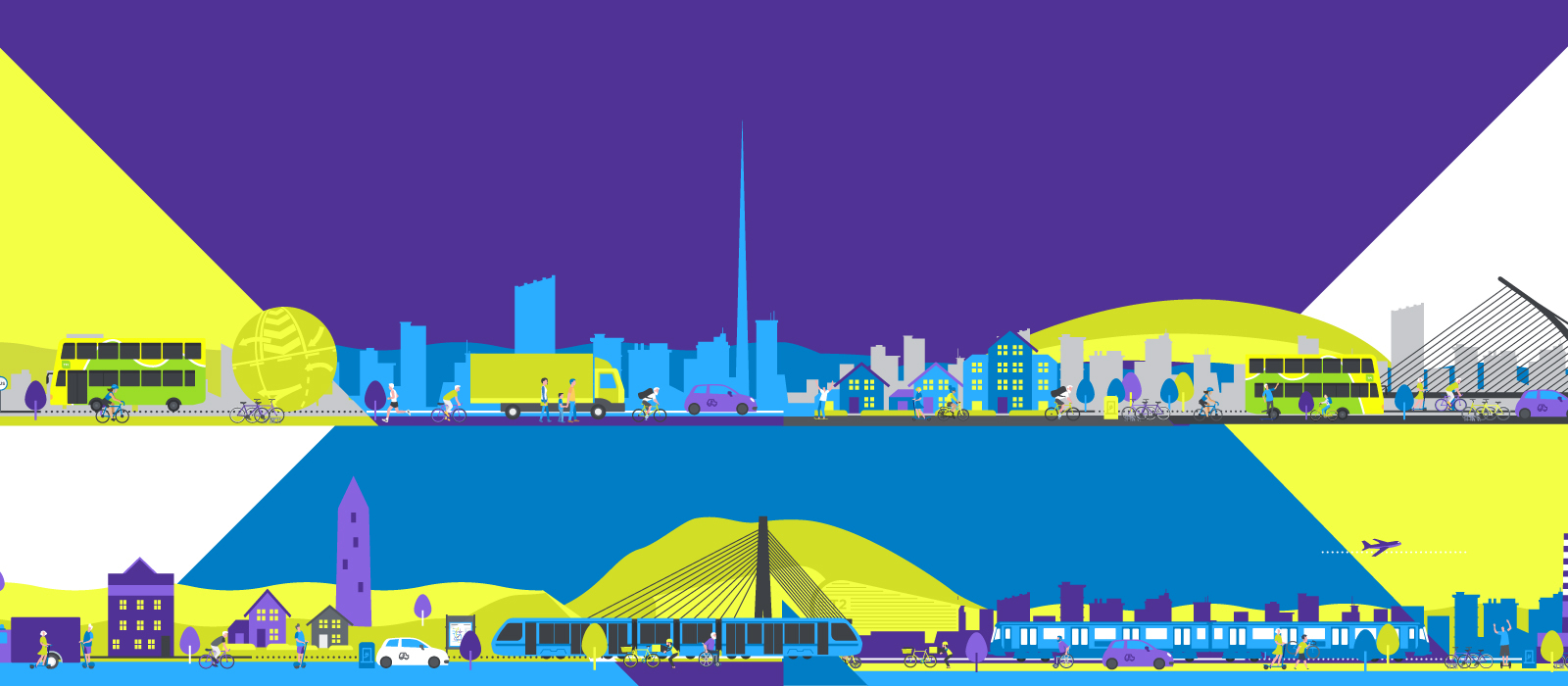Transition away from fossil fuels will slash public transport emissions
PSO bus and commuter rail fleet in the Greater Dublin Area will be 100% electric and zero emission by 2035 according to proposals in the NTA’s draft revised GDA Transport Strategy 2022-2042 published today.
NTA has published the Strategy today for public consultation. NTA is required under statute to review the GDA Transport Strategy every six years and today’s document is a revision of the current plan that was adopted by Government in 2016.
Under the Strategy, greenhouse gases linked to public transport will fall dramatically. This will come about as a result of further investment in Dart and Luas, which are already fully electric, but also as a result of the complete transition away from fossil fuels for buses within 13 years.
Overall transport emissions are to fall by 51% by 2030 under the Climate Action Plan published recently and by 69% over the course of this Strategy, but transitioning fleet to zero-emission fleet means that public transport itself will go beyond those figures.
Transport proposals we are bringing forward, including an acceleration of investment in walking and cycling infrastructure will also deliver substantial greenhouse gas reductions during the lifetime of this strategy.
However, additional measures will be required to further incentivise a move away from diesel and petrol fuelled journeys. To that end, NTA will undertake a detailed assessment of such measures – particularly in the area of demand management – which is likely to include: new parking arrangements; zonal charging; tolling and road pricing; and further vehicle electrification.
The 2022-2042 document seeks to build on the elements already delivered under the 2016-2035 Strategy, and also to reiterate commitments already in place. In addition it adds new elements and new projects to reflect the evolution of the national policy framework since 2016 such as the NDP and the Climate Action Plan.
Among the elements of 2016-2035 Strategy that have been completed or significantly progressed are:
- Luas Cross City
- Phoenix Park Tunnel
- Roll out of cycle tracks and greenways
- Metrolink
- DART+ Programme
- BusConnects Programme including new network, core bus corridors and transition to low-emission fleet
Among the elements that have already been proposed and which are to be further progressed and delivered during the lifetime of this Strategy are:
- All elements of Bus Connnects Dublin
- Increased bus prioritisation on regional bus corridors including on approaches to the M50 and the built-up area of the city
- Revised and enhanced GDA Cycle Network Plan
- Provision of high-quality pedestrian facilities and pedestrianised routes
- Next Generation Ticketing
- Luas extensions to Finglas, Lucan, Poolbeg and Bray
- 100km of electrified rail under DART+ Programme
- Metrolink from north of Swords to Charlemont
- Upgrade of capacity for Luas Green Line
Newly-proposed plans in this Strategy include:
- Provision of a new rail line from the M3 Parkway to Navan;
- Extending the DART+ programme to deliver electrified rail services to Sallins/Naas, Kilcock and Wicklow
- The planning and design of a further 8 Luas extensions/ new Luas lines to be ready for construction post 2042:
- Luas to Clongriffin
- Luas to Balgriffin
- Luas extension to Tyrellstown
- Luas to Blanchardstown
- Luas extension to Clondalkin
- Luas to Tallaght / Kimmage
- Luas to Tallaght / Knocklyon
- Luas to UCD / Sandyford (reduces future passenger congestion on the Green Line in the future)
See more details in the NTA GDA Transport Strategy 2022-42 document here.
NTA Chief Executive Officer Anne Graham said:
“There is no doubt that people are looking to us to provide better, more sustainable transport alternatives in all areas, so it is incumbent on us as an Authority to respond to that in a positive way. I believe that this Strategy has the potential to be truly transformative from that point of view.
As far as NTA is concerned, the single biggest step that can be taken to tackle climate change is to encourage as many people as possible to use public transport and other sustainable modes, rather than the private car. In broad terms, our Strategy will facilitate this by investing in services and infrastructure, now and into the future.
But we can’t do this on our own. Some of the other measures needed to reduce emissions that are identified in this document may be challenging and will require action not just from NTA but from a range of other public authorities, state agencies and Government departments.
We in the NTA want to play our part and we want to lead by example, and we will do that by transitioning our public transport fleet away from fossil fuel to low and zero emission technologies. This process is already under way, and when complete in 2035 will result in a massive reduction in public transport emissions.
But now we want to get the views of members of the public. I would invite you to go to the Transport Strategy for the Greater Dublin Area section on our website to read about our proposals and to have your say. We’d like you to let us know what you think. If there are improvements you think we should make, please let us know. If you think we have missed something or have not paid it adequate attention, this is your opportunity to share that with us.
This is a unique opportunity for us all to help shape the future of this region.”
